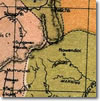A city in the North Coast district of New South Wales, situated on the Clarence River, about 640 kilometres north of Sydney and 350 kilometres south of Brisbane. The older parts of Grafton were established on the river’s flood plain, resulting in the city’s inundation on a number of occasions during the nineteenth and twentieth centuries. Since the 1960s, however, the construction of flood levees and Grafton’s subsequent development on higher ground have helped to mitigate these crises.
European contact with the area was first recorded in 1831, when an escaped convict, Richard Craig, agreed to lead a party up the ‘Big River’ for his pardon and a hundred pounds. The area, known by local Aborignes as ‘Booryimba’, was rich with cedar and, upon hearing of Craig’s venture, a Sydney ship builder, John Small, sailed up the Clarence and formed a settlement on Woodford Island. By 1838, several small vessels were already trading to Sydney, taking down cedar and bringing back supplies. In response to the region’s increasing number of settlers, William Borlace Wilson and his brother Christopher were sent as contract surveyors in 1839 to report on the whole district. Shortly thereafter, William Wedge Darke arrived to lay out the town, then known only as ‘The Settlement’. In 1848, when Darke’s work was completed, Governor Fitzroy offcially named the town Grafton after his grandfather, the Duke of Grafton. By 1851, the town was sufficiently populated to justify the sale of land blocks.
Grafton, which was proclaimed a municipality in 1859 and a city in 1885, was soon thriving. Sheep had been introduced to the region in the 1840s, and the resulting trade in wool brought new buildings and commercial enterprises to the town. But it was not until 1857, when farmers from the Hunter and the Hawksberry arrived to clear the land and in the process discovered its arable soil, that Grafton became the prosperous ‘hub’ of this agriculturally rich region. Sugarcane, which became the staple of the local economy, was grown in the region from the late 1860s. Within a short time, literally dozens of sugar mills had opened around the district. A courthouse and hospital had already been established, in 1861, and a gaol erected around the same time. A local newspaper, the Examiner, had been operating since 1859. Churches which had been established during Grafton’s early years moved from humble weatherboard shacks to magnificent brick buildings (such as Christ Church Cathedral, designed by the eminent Australian architect, John Horbury Hunt, and finished in the 1890s; St Andrews Presbyterian Church, finished in 1886; and St Mary’s Catholic Church, finished in 1867). A public school was transferred to permanent premises in 1871, and a grammar school (which later became Grafton High School) opened in 1877. By the mid 1880s the town was lit with gas.
Despite Grafton’s impressive development during the 1860s and 1870s, the town was devastated by the New South Wales government’s decision to extend the Northern Railway through Armidale and Glen Innes instead of what many townspeople regarded as the natural port for the New England region. A series of natural and economic disasters during the 1890s temporarily disrupted Grafton’s spectacular growth, but the rural community again adapted and by the turn of the twentieth century it had become an important centre for the dairying industry. North and South Grafton, physically separated by the Clarence River, were finally connected in 1932 when the Grafton Bridge was completed. As a result, the entire town was now connected by railway to both Sydney and Brisbane.
Grafton remains a service city for the largely pastoral activities which occupy its surrounding districts in the Clarence Valley. More than two-thirds of this land is committed to commercial agriculture and Grafton provides a convenient distribution point for its goods and produce. The city is known for its Jacaranda trees and Jacaranda Festival (the oldest floral festival in Australia), magnificent tree-lined streets, extraordinary range of parks and playgrounds, and historic buildings (including the Clock Tower in Grafton’s main street, built in 1909 to commemorate the city’s Jubilee). The Clarence River hosts annual events such as the Bridge to Bridge Ski Race, Sailing Classic and numerous rowing regattas.Related Bodies: Related People: References:
Mary Bate and Nola Mackey, The City of Grafton (Grafton: Grafton City Council, 1981); City of Grafton, Back To Grafton Week: Official Souvineer (Brisbane: WR Smith and Paterson, 1932); and http://www.graftoncity.nsw.gov.au/about_grafton.
htm.
|

